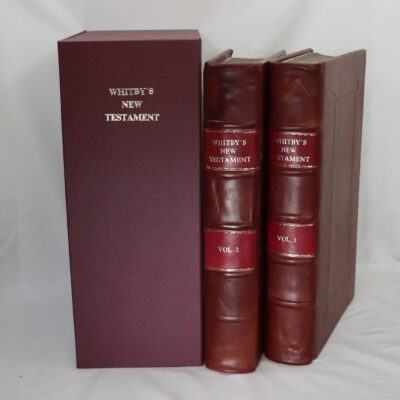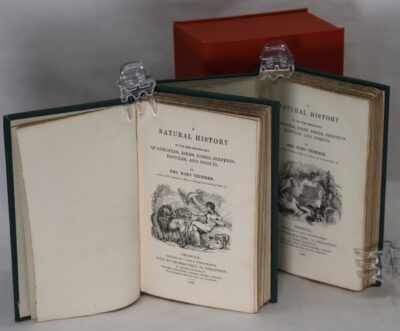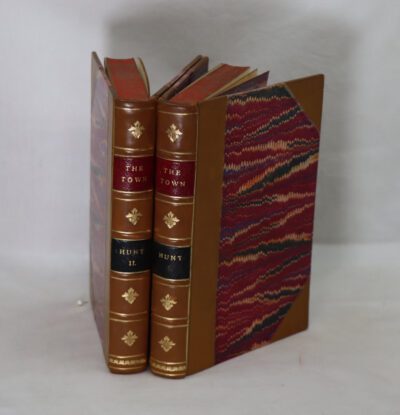Tales of my Landlord. Volumes I, II, III & IV.
By Jedediah Cleishbottom
Printed: 1816
Publisher: William Blackwood. Edinburgh
| Dimensions | 12 × 18 × 2.5 cm |
|---|---|
| Language |
Language: English
Size (cminches): 12 x 18 x 2.5
Condition: Fine (See explanation of ratings)
Item information
Description
Olive calf spine with marbled boards. Gilt spine decoration. Set of four volumes.
A very interesting precursor edition
Tales of my Landlord is a series of novels by Sir Walter Scott (1771–1832) that form a subset of the so-called Waverley Novels. Of these, The Heart of Midlothian and The Bride of Lammermoor have been the most successful, and Old Mortality is considered by modern critics to be among Scott’s best work. The fourth were the least successful.
They were so called because they were supposed to be tales collected from the (fictional) landlord of the Wallace Inn at Gandercleugh, compiled by a “Peter Pattieson”, and edited and sent to the publisher by Jedediah Cleishbotham. This is gone into in great depth in the introduction to The Black Dwarf.
The first series was planned to comprise four volumes, each containing a separate novel, but Scott — by his own admission — botched The Black Dwarf, and Old Mortality came to be three volumes in its own right. The other three series thus consisted of two volumes each, or just one, in the case of the second.
They were supposed to reflect aspects of Scottish regional life.
Jedediah Cleishbotham is an imaginary editor in Walter Scott’s Tales of My Landlord. According to Scott, he is a “Schoolmaster and Parish-clerk of Gandercleugh.” Scott claimed that he had sold the stories to the publishers, and that they had been compiled by fellow schoolmaster Peter Pattieson from tales collected from the landlord of the Wallace Inn at Gandercleugh. For more information, see the introduction to The Black Dwarf by Scott.
Sir Walter Scott, 1st Baronet FRSE FSAScot (15 August 1771 – 21 September 1832), was a Scottish historical novelist, poet, playwright and historian. Many works remain classics of European and Scottish literature, notably the novels Ivanhoe, Rob Roy, Waverley, Old Mortality, The Heart of Mid-Lothian and The Bride of Lammermoor, and the narrative poems The Lady of the Lake and Marmion. He had a major impact on European and American literature. As an advocate, judge and legal administrator by profession, he combined writing and editing with daily work as Clerk of Session and Sheriff-Depute of Selkirkshire. He was prominent in Edinburgh’s Tory establishment, active in the Highland Society, long a president of the Royal Society of Edinburgh (1820–1832), and a vice president of the Society of Antiquaries of Scotland (1827–1829). His knowledge of history and literary facility equipped him to establish the historical novel genre and as an exemplar of European Romanticism. He became a baronet “of Abbotsford in the County of Roxburgh”, Scotland, on 22 April 1820; the title became extinct on his son’s death in 1847.
Although he continued to be extremely popular and widely read, both at home and abroad, Scott’s critical reputation declined in the last half of the 19th century as serious writers turned from romanticism to realism, and Scott began to be regarded as an author suitable for children. This trend accelerated in the 20th century. For example, in his classic study Aspects of the Novel (1927), E. M. Forster harshly criticized Scott’s clumsy and slapdash writing style, “flat” characters, and thin plots. In contrast, the novels of Scott’s contemporary Jane Austen, once appreciated only by the discerning few (including, as it happened, Scott himself) rose steadily in critical esteem, though Austen, as a female writer, was still faulted for her narrow (“feminine”) choice of subject matter, which, unlike Scott, avoided the grand historical themes traditionally viewed as masculine.
Nevertheless, Scott’s importance as an innovator continued to be recognised. He was acclaimed as the inventor of the genre of the modern historical novel (which others trace to Jane Porter, whose work in the genre predates Scott’s) and the inspiration for enormous numbers of imitators and genre writers both in Britain and on the European continent. In the cultural sphere, Scott’s Waverley novels played a significant part in the movement (begun with James Macpherson’s Ossian cycle) in rehabilitating the public perception of the Scottish Highlands and its culture, which had been formerly been viewed by the southern mind as a barbaric breeding ground of hill bandits, religious fanaticism, and Jacobite risings.
Scott served as chairman of the Royal Society of Edinburgh and was also a member of the Royal Celtic Society. His own contribution to the reinvention of Scottish culture was enormous, even though his re-creations of the customs of the Highlands were fanciful at times. Through the medium of Scott’s novels, the violent religious and political conflicts of the country’s recent past could be seen as belonging to history—which Scott defined, as the subtitle of Waverley (“‘Tis Sixty Years Since”) indicates, as something that happened at least 60 years earlier. His advocacy of objectivity and moderation and his strong repudiation of political violence on either side also had a strong, though unspoken, contemporary resonance in an era when many conservative English speakers lived in mortal fear of a revolution in the French style on British soil. Scott’s orchestration of King George IV’s visit to Scotland, in 1822, was a pivotal event intended to inspire a view of his home country that, in his view, accentuated the positive aspects of the past while allowing the age of quasi-medieval blood-letting to be put to rest, while envisioning a more useful, peaceful future.
After Scott’s work had been essentially unstudied for many decades, a revival of critical interest began in the middle of the 20th century. While F. R. Leavis had disdained Scott, seeing him as a thoroughly bad novelist and a thoroughly bad influence (The Great Tradition [1948]), György Lukács (The Historical Novel [1937, trans. 1962]) and David Daiches (Scott’s Achievement as a Novelist [1951]) offered a Marxian political reading of Scott’s fiction that generated a great deal of genuine interest in his work. These were followed in 1966 by a major thematic analysis covering most of the novels by Francis R. Hart (Scott’s Novels: The Plotting of Historic Survival). Scott has proved particularly responsive to Postmodern approaches, most notably to the concept of the interplay of multiple voices highlighted by Mikhail Bakhtin, as suggested by the title of the volume with selected papers from the Fourth International Scott Conference held in Edinburgh in 1991, Scott in Carnival. Scott is now increasingly recognised not only as the principal inventor of the historical novel and a key figure in the development of Scottish and world literature, but also as a writer of a depth and subtlety who challenges his readers as well as entertaining them.
Want to know more about this item?

Related products
Share this Page with a friend















